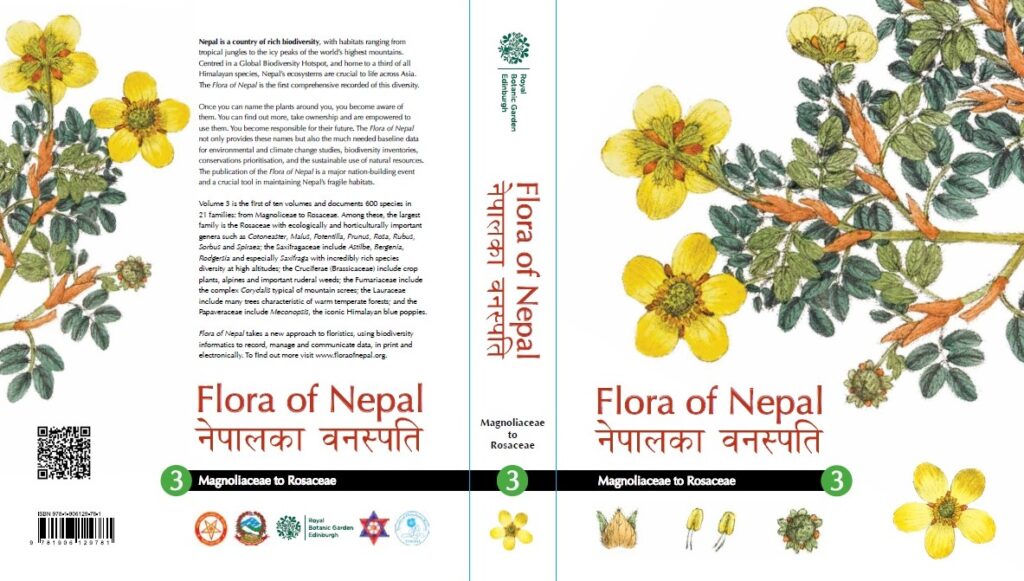Nepal has failed to prepare a complete description of flora in the country, 23 years after an agreement to publish a comprehensive record of flowering and non-flowering plants found in Nepal.
In 1992, Nepal became a signatory country to the first International Convention on Biological Diversity and ratified the treaty in the same year. Nepal promised to get ready a description of plants under biological diversity within 2020. But the commitment has been fulfilled with only one volume published to date.
An agreement was signed between the Nepal Academy of Science and Technology (NAST), the University of Tokyo, and the Royal Botanical Garden Edinburgh (RBGE) in 1999 to publish ‘Flora of Nepal’ in 10 volumes with a comprehensive record of flowering and non-flowering plants of Nepal.
The Royal Botanical Garden Edinburgh was assigned to publish Volumes 3 and 7. Volume 3, the first volume of ten volumes of Flora of Nepal with six hundred species in 21 families from Magnoliceae to Rosaceae, was published in 2011. The seventh volume is in the process of its completion.

Nepal was tasked to complete Volume 10 but has not even done 10 percent of the work. The volume is divided into two parts: 10(1) and 10(2), from the family Acoraceae to the family Orchidaceae.
Earlier, the University of Tokyo had given the task of Volume 4 completion, but the university did not accomplish it within the given deadline. The volume consists of Leguminosae to Spindaceae families.
‘The Flora of Nepal’ is a comprehensive list of plants found in the country with detailed information, including the place of origin.
The research book contains all the flowering plants found in Nepal to date including the details of a plant’s location, identification, morphological structures, and other taxonomical information. More than one hundred thousand herbarium specimens are collected and stored in the National Herbarium and Botanical Laboratory under the Department of Plant Resources(DPR) in Godawari for publication.
The DPR has been assigned the responsibility to prepare the publication, and the Central Department of Botany, Tribhuvan University has been given the responsibility of providing technical manpower and taxonomists, where the DPR will provide the testing and writing assistance. It is mentioned that the Nepal Academy of Science and Technology will play the role of international facilitator.
A recent ninth international editorial meeting at NAST had decided to publish all 10 volumes by 2030. The chief editor of FoN is Dr. Mark F. Watson. He is affiliated with RBGE. The editors are Dr.Keshab Raj Rajbhandari and Prof. Dr. Krishna Kumar Shrestha from Nepal, Dr. Shinobu Akiyama from the National Science Museum in Japan, Prof. Dr. Hiroshi Ikeda from the University of Tokyo, and Dr. Colin A. Pendry from RBGE. These botanists are experts in the taxonomy and nomenclature of plant species.
Mark F. Watson the head of major Floras at RBGE, is optimistic about accomplishing the task and finishing work on all the volumes in the new provided time frame.
“Enthusiasm and activity on the flora of Nepal are rising with each day, and we are all very optimistic about completing the much-needed comprehensive scientifically authoritative documentation of the plants of Nepal timely,” said Watson.
“There is a pressing need for this data, and the authors set the ambitious target of completing the publication by 2030, in line with the Montreal-Kunming Global Biodiversity Framework.”
According to Saroj Chaudhary, deputy director general at the Department of Plant Resources, the meeting decided to publish three volumes by December 2025 and all the remaining volumes by 2030. Chaudhary said that the families in Volume 1 (Pteridophytes and Gymnosperms) and 9 (Cyperaceae and Poaceae) will be handled by Nepal, Volumes 5 (Apiaceae, etc.) and 6 (Ericaceae, Primulaceae, Gentianaceae, etc.) by the UK, and Japan is given responsibility for Volume 2 (Ranunculaceae, Caryophyllaceae, Polygonaceae) and 8 (Asteraceae, Campanulaceae, Rubi, etc.).
For timely publication and sorting out the editing process, the relevant persons decided to hold an online meeting every six months to improve the editorial process by strengthening the coordination and efficiency of the editorial team (editors and volume editors) and to develop editorial skills in Nepal in the next generation.
Earlier, the contributor used to work on a volunteer basis. and decided to seek additional funds and resources for the timely completion of this project.
“The meeting decided on providing additional resources to the contributor. This will give rise in the number of contributors and interns working on this project,’ said Sandesh Bhattarai, a taxonomist working at NAST.
He said that the meeting decided to maximize the quality of accounts through the early involvement of global experts in plant groups. By linking in with the World Flora Online Taxonomic Expert Networks, Flora of India/Botanical Survey of India, Flora of Thailand, and Flora of the Pan Himalaya and making use of published illustrations in the Flora of Bhutan, Flora of China, and Flora of India, and looking to utilize drawings in postgraduate student thesis and potentially the Flora of Pakistan.
Watson said that the active participation of botanists is creating hope for timely publication.
“I am very pleased with the active participation of botanists in Nepal in recent times, particularly the younger generation and their inspiring seniors and I am confident that the flora is now on the right track and will be completed,” he said.


